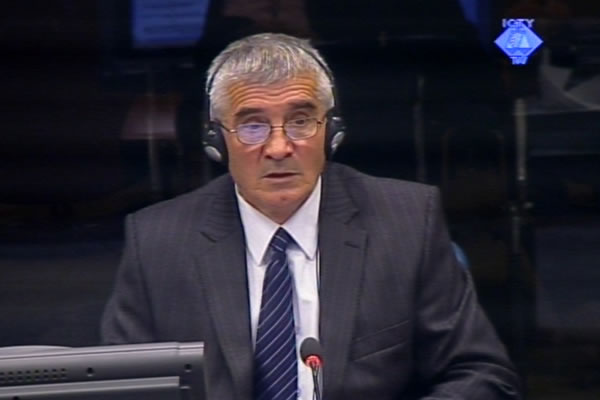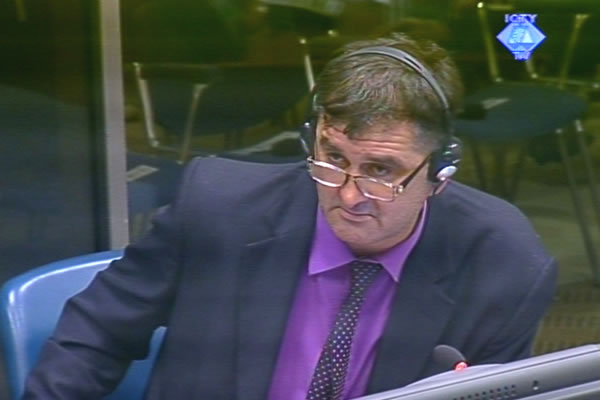Home
PEACE INITIATIVES AND ATTACKS IN RAJLOVAC
Radovan Karadzic’s defense witness claims that Serbs in the Rajlovac area launched peace initiatives, while Muslims launched attacks. The prosecution contends that the capture of Ahatovici was part of a wider plan to remove Croats and Muslims from towns and villages in the Serb municipality of Rajlovac
 Stojan Dzino, defence witness of Radovan Karadzic
Stojan Dzino, defence witness of Radovan Karadzic From March to May 1992, Stojan Dzino took part in the night watch organized in the village of Bojnik in Rajlovac municipality. The summary of Dzino’s statement to the defense was read out by Karadzic. In it, Dzino says that Muslims in Ahatovici were arming themselves while the Serbs were launching initiatives to rebuild trust. An attack by the Muslims on the village of Krstac on 29 May 1992 put a stop to the peace initiatives. The witness contends that on 2 June 1992 there was a clash in Ahatovici when ‘several Muslims were arrested and some were killed’. However, ‘there were not dishonorable activities’ - killings, abuse and rape - in the area of combat operations where Dzino was. The members of Dzino’s unit always treated prisoners in line with the Geneva Conventions. The witness took out from his pocket a booklet with the Geneva Conventions, claiming that he had received it from his superiors at the very beginning of the war.
In his responses to the prosecutor, Dzino confirmed that there were ‘rumors’ about hundreds of women, children and men from Ahatovici that were detained in several locations in Rajlovac. The witness said he ‘had no details about it’. When the prosecutor noted that all Muslims were removed from Ahatovici, Dzino replied that ‘some people were removed, others left voluntarily’. The witness said he was sorry ‘if it is true’ that some of them were beaten to death and held captive in inhumane conditions.
The witness claimed that nobody ever ordered him to seize Ahatovici arguing that it was a defense operation in response to the mortar attacks launched from the village. Prosecutor Gaynor put the prosecution case to the witness: Serbs captured Ahatovici as ‘part of a plan coordinated at the highest level with the aim of removing all Muslims and Croats from the Serb municipality of Rajlovac’. The witness disagreed, saying that Rajlovac had seceded from the municipality of Novo Sarajevo solely for economic reasons.
The second defense witness today was Predrag Trapara, commander of one of the companies in the 1st Sarajevo Mechanized Brigade. As usual, Karadzic read out the summary of Trapara’s statement. In September 1991, Trapara saw Muslims were getting armed and Juka Prazina was patrolling with his paramilitaries on Mount Mojmilo. The witness said he had information that the Bosnian side used civilian facilities for military purposes. Karadzic asked Trapara to clarify an incident involving the police in October 1991. According to Trapara, his cousin Ignjatije woke him up one night and asked him to help load some items on a truck. Trapara claimed he didn’t know what the items were. When the police stopped them, Trapara found out the truck was full of weapons and ammunition. Trapara spent a little less than a month in detention and was given a suspended prison sentence by a military court.
In cross-examination, Trapara claimed he didn’t know how many weapons there were. When the prosecutor confronted him with a police report, Trapara agreed that the list of recovered weapons was ‘almost correct’ and denied only that there were two mortars in the truck. The police report stated that the trucks contained mortars, several crates of automatic rifles, seven semi-automatic rifles, two machine guns, more than 10,000 rounds and cleaning kits. Finally, Trapara admitted that he had agreed to assist in the transportation of the weapons because, as he explained, he ‘wished to help the frightened Serb people’.
Photos
Linked Reports
- Case : Karadzic
- 2012-11-06 ‘JOINT COMMISSION’: DID IT REALLY EXIST?
- 2012-11-05 MOMIR CLAIMS HE’S ‘MOCALO’ NOT ‘MOMO’
- 2012-11-01 RESPONSIBILITY FOR MARKALE MASSACRE CONTESTED AGAIN
- 2012-11-08 KARADZIC’S WITNESS: BOSNIAN GOVERNMENT KILLED PEOPLE IN SARAJEVO
- 2012-11-12 KARADZIC’S WITNESS DENIES ‘PUNISHMENT SHELLING’
- 2012-11-13 KARADZIC HOPES ORIC MIGHT HELP HIM

